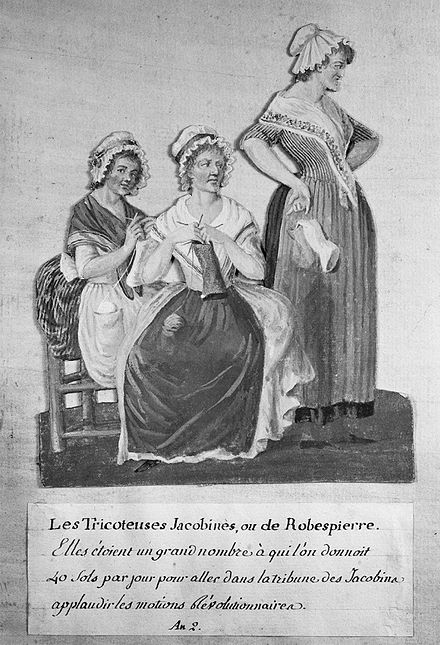
With (or without your permission), here we have a brief digressive look at famous knitters in literature (knit lit). I hate when there is a phrase that is close to a phrase that is to be avoided at all costs.
We have a musical theme for this digression.
There is no more famous knitter in literature than Madame Defarge in A Tale of Two Cities by Charles Dickens.

She is a ringleader of the tricoteuses, a tireless worker for the French Revolution, and the wife of Ernest Defarge.

Tricoteuse is French for a knitting woman. The term is most often used in its historical sense as a nickname for the women who sat beside the guillotine during public executions in Paris in the French Revolution, continuing to knit in between executions. Amongst the items they knitted was the famous liberty cap or Phrygian cap.

Some historians have suggested that Dickens based Defarge on Anne-Josèphe Théroigne de Mericourt, a revolutionary who played a key role in street demonstrations.
Madame Defarge is one of the main villains of the novel, obsessed with revenge against the Evrémondes. Dickens created The Marquis St. Evrémonde as the epitome of pitiless, arrogant, French aristocracy.

Other literary knitters are not evil – Jane Fairfax and Mrs. Bates in Jane Austen’s Emma, Mrs. Smith and Nurse Rooke in Jane Asuten’s Persuasion, Mrs. Gummidge and Mrs. Peggotty in Charles Dickens’ David Copperfield, Miss Ophelia in Harriet Beecher Stowe’s Uncle Tom’s Cabin, Brigitte and Madame Thuillier in Honoré de Balzac’s Les Petits Bourgeois, Anna Makarovna in Leo Tolstoy’ War and Peace, Mrs. Elliot and Mrs. Thornbury in Virginia Woolf’s The Voyage Out, and Miss Marple in Agatha Christie’s novels. Jane Marple is an elderly spinster who lives in the village of St. Mary Mead and acts as an amateur consulting detective
While we are on the subject of knitting…..

In 1966 or 1967 I started to collect santons that I first bought at a gift shop in Damariscotta, Maine. Santons (“little saints”) are small hand-painted terracotta nativity scene figurines produced in the Provence region of France. In a traditional Provençal crèche, there are 55 individual figures representing various characters from Provençal village life such as the scissors grinder, the fishwife, the blind man, the chestnut seller, and the knitter. Today I have a large collection of santons. Now you know.
Final knitting digression… One of our traditional rivals in high school sports was the William Penn Charter School, known as simply “Penn Charter.” It is the oldest Quaker school in the country. It was established in 1689, 96 years before my school.
I mention Penn Charter because one of our school’s cheers when playing against Penn Charter was “Knit one, purl two/ Penn Charter, boo-hoo.” Good one, no?
I showed this post to my friend and asked for his opinion, even though it will be an unlisted post.

He handed me this photo. “Your sister mailed it to me, said to surprise you with it sometime. SURPRISE!”
I was six or seven, so Jeanne was four or five. The photo is in South Bristol, Maine. I was profoundly happy there in summer as a little boy.
I thanked him for the surprise and asked for his opinion on this brief look at knit lit. He was only too happy to respond:


